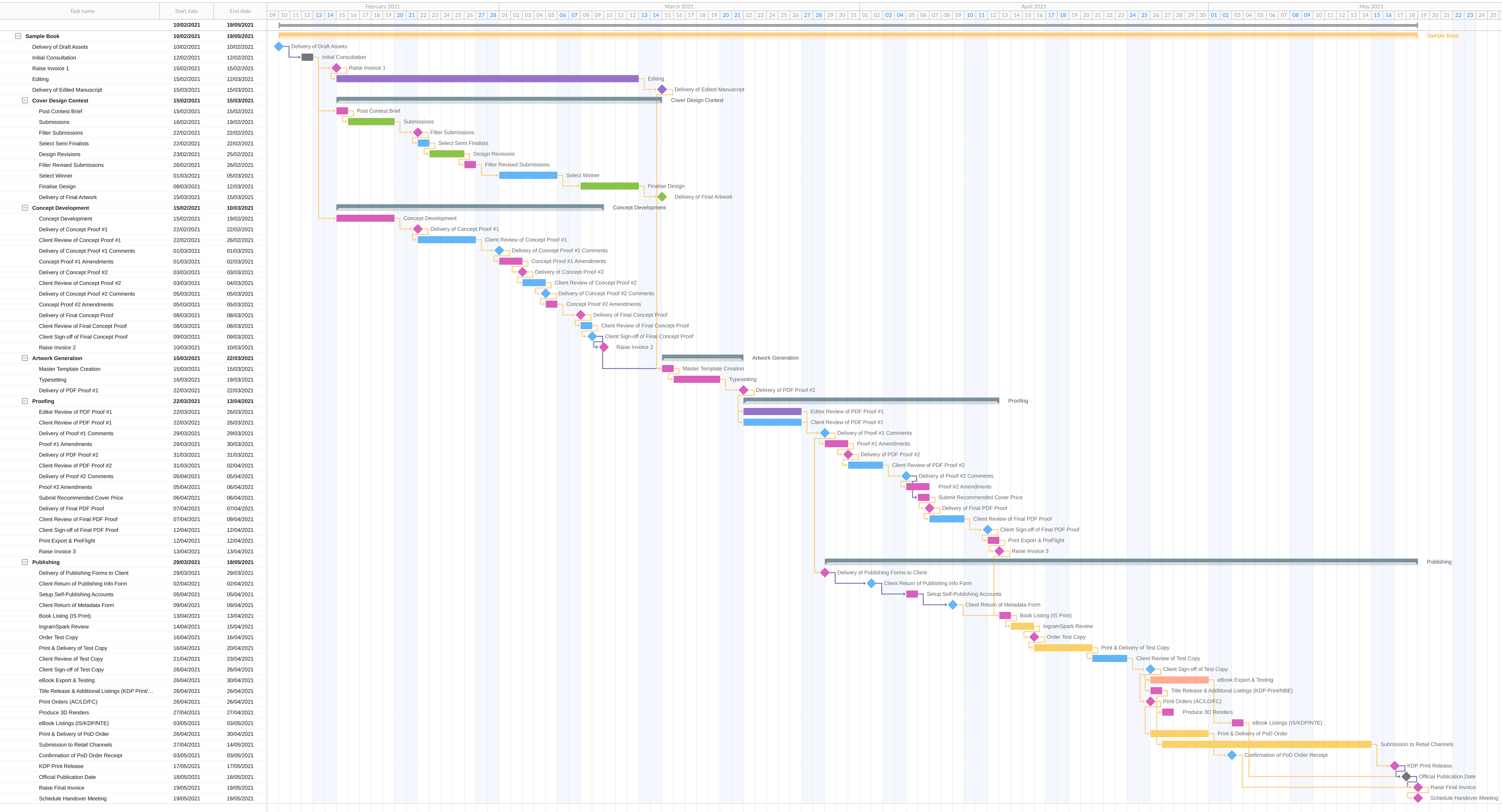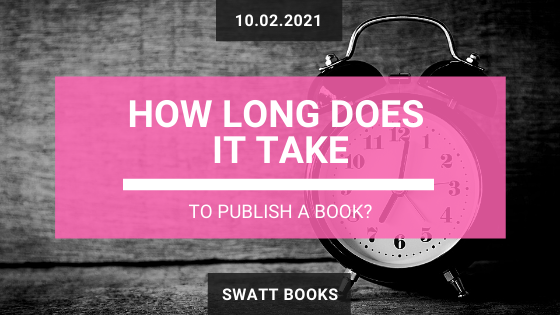In a number of my recent articles on the blog, I’ve been talking about the importance and benefits of book planning, and an integral part of a good book plan is a publishing schedule. If you’re anything like me, having concrete deadlines helps me keep on track and stay accountable; especially when I’m working on one of my own books as opposed to a client project. But if this is the first time you are publishing a book, how do you how much time to realistically budget for each stage of the self-publishing process?
So, in this article, I’m going to give you some rough guidelines to work from as to how long it takes to self-publish a book when done properly.
You may have noticed that in the title for this article, I specified “to Self-Publish a Competitive Book”. The reason for this distinction is that in theory you can publish a book via Amazon KDP in as little as 72 hours. But as with most things, you get out what you put in. To publish a book within three days of writing it means that you are not giving your book enough thought to ensure that it is going to be successful. Remember that you only get one chance to make a first impression. So, if you want your book to make a good impression, you need to give it the time and attention it deserves.
That being said, what attention does it need and how long will that attention to detail take?
Editing – 4 to 10 weeks
Only an author who doesn’t really care about the content of their book will publish it without having it properly edited. The amount of time it takes to edit a book manuscript depends on 4 factors:
- How long the book is. This is simple mathematics; it takes less time to edit 10k words as it does to edit 50k words.
- The type & complexity of content. Fiction takes longer to edit than non-fiction. However, non-fiction books that contain a lot of cross-references, copyrighted material, or advanced/technical material will take longer to edit than a straightforward ‘how-to’ guide or biography.
- The level of editing required. There are three levels of editing that can be performed on your book ranging from simple proofreading on one end of the scale, to line editing as a middle option, and in-depth developmental editing on the other end of the spectrum. Each require increasing amounts of time to complete.
- Editors workload. Editors are businesses as well who often have other clients and priorities demanding their attention. They may not be able to start editing your book straight away, or they need to divide their time between you and another author. And because of the level of concentration and skill required to edit a book, many editors will only work on one book at a time.
Scheduling Tip: Send a draft copy of your book (or a couple of chapters) to your chosen editor for them to get a sense of the content and scope of your book, as well as your writing style. From that, they should be able to extrapolate a rough estimate of how long it will take them and costs to edit your book.
If you need help finding a professional editor, check out the Chartered Institute of Editing and Proofreading (https://www.ciep.uk). They have a searchable directory of all their member editors, plus details of their skills, subject specialisms and services they offer.
Design & Typesetting – 2 to 8 weeks
Despite the old adage, people do judge a book by its cover, so you need to give this its’ due attention if you want that judgement to be positive instead of negative. Likewise, how the interior of your book is typeset will have an impact on whether your readers find it easy to read your book or not. Now the amount of time that designing your book cover and typesetting the interior contents takes primarily depends on whether you are doing it yourself or you are hiring professional help.
If you hire a professional designer, this is what a typical book design schedule entails:
- Cover Design
- Initial concept development – 1 week
- 2 to 3 rounds of concept proof reviews – 2 to 3 weeks
- Interior Design & Typesetting
- Initial concept development – 1 week
- 2 to 3 rounds of concept proof reviews – 2 to 3 weeks
- Typesetting – 3 to 10 days
- 2 to 3 rounds of proof reviews – 2 to 3 weeks
*Note that cover design and interior design & typesetting are usually done at the same time.
If you are going to do the design and typesetting of your book yourself, you obviously save yourself time by not needing to do back and forth proof reviews, however you do need to take into account your skill level and learning curve.
Scheduling Tip: I recommend starting your cover design and interior concept development while your editor is working on the initial line edit of your book as this can save your about 4 weeks on your overall schedule.
If you want some more information on the book design process, check out my blog article “The Book Design Process”. You might also find “Book Design Secrets from a Professional Book Designer” and “How to Write a Kick-Ass Book Cover Design Brief” useful.
Publishing – 3 to 6 weeks*
The actual publishing process involves a lot more steps than most first-time authors realise if you want to do it properly. Most of the steps are fairly simple and don’t take much time at all but seeing as they need to be done in a particular order, those short amounts of time do start to stack up. Here’s a brief outline of the steps involved:
- Registering your publishing Imprint & purchasing ISBN numbers – 1 day
- Drafting your book metadata – 1-2 days
- Setting up publishing accounts with Amazon KDP and Ingram Spark – 1 day
- Submitting your book to Ingram Spark (including Ingram’s artwork check) – 3 days
- Ordering a printed test copy for final review – 5-7 days
- Converting approved print book to eBook – 3-5 days
- Submitting approved print book to Amazon KDP – 1 day
- Submitting converted eBook to Ingram Spark and Amazon KDP – 1 day
- Release for public distribution (including time for book listings to appear across all retail channels) – 3 to 14 days
*Note that this schedule does not include a pre-sale period, which I do recommend that authors include in order to help boost initial Amazon Rankings.
Scheduling Tip: Do NOT rush through drafting your metadata; it is probably the most important step here, and the one that authors often don’t give enough thought to. Metadata is how your book actually gets found by people who do not know you or know that you have written a book, so take your time with this step
If you want some more information on what good metadata includes and some advice on how to write quality metadata for your book, check out my blog article “Book Metadata: The Ultimate What, Why & How Guide”.
For all you visual people out there, here is what that schedule looks like as a Gantt chart. This is a sample production schedule for an average 50k word non-fiction book if you were to opt for my All-Inclusive publishing package.

So, there you have it; in 3-4 months you can go from raw manuscript to a professional quality book available worldwide in both print and eBook. Now that you have an understanding of the steps involved and how long it takes to self-publish a quality book, you can not only put together a comprehensive publishing plan for your book, but you can also start to be more effective in your marketing by priming your readers with an anticipated release date for your book well in advance.
This system can also be used to reverse engineer a publishing schedule. If you have a particular date that you want your book to be available for, you can use this timeline to generate a work-back schedule that gives you dates of when tasks need to be completed in order to hit your publishing deadline.





